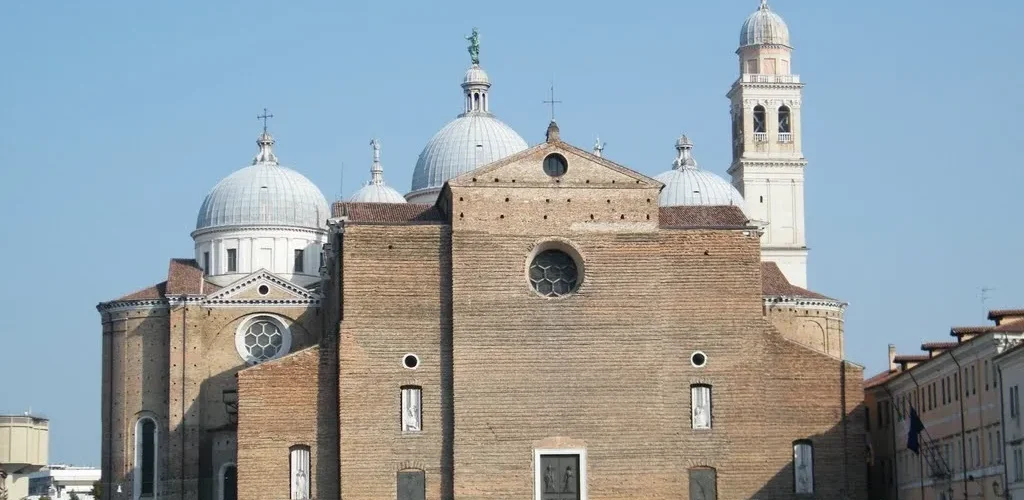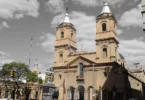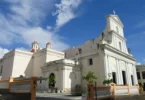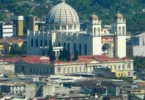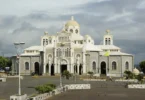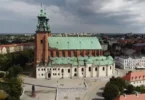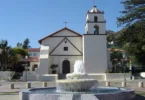Introduction
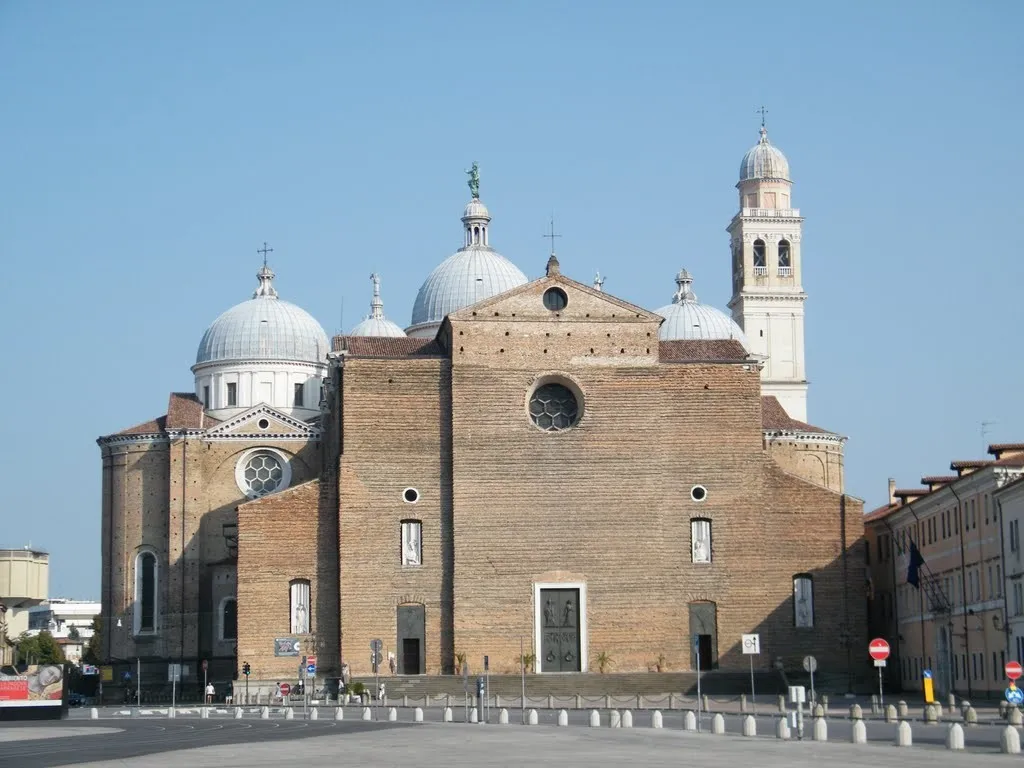
The Abbey of Santa Giustina is a historic Benedictine monastery complex dating back to the 10th century, located in the heart of Padua, in the Veneto region of northern Italy. Situated directly across from the iconic Prato della Valle, one of the largest squares in Europe, the abbey has played a significant role in the religious and cultural life of the city for over a millennium. The abbey’s central structure is the Basilica of Santa Giustina, which was originally constructed in the 6th century. However, much of its current appearance and architectural style is a result of a major reconstruction that took place in the 17th century, which gave the church its present-day Baroque design. The complex remains an important site for both pilgrims and visitors, offering a blend of historical architecture, religious significance, and stunning views of the surrounding area.
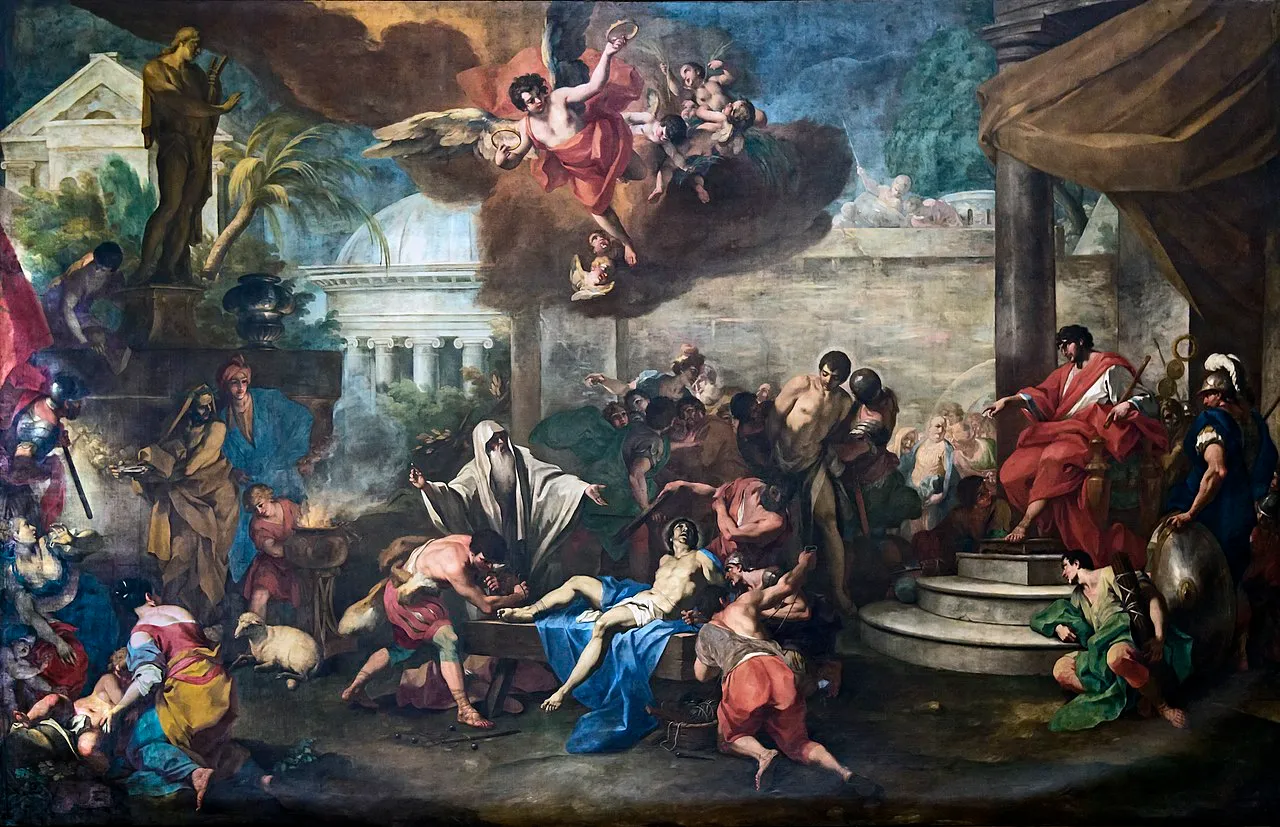
The Abbey of Santa Giustina has a rich and complex history that spans over a millennium, marked by periods of growth, destruction, and revitalization. The site where the abbey now stands was home to a church dedicated to Saint Justina of Padua and other 4th-century Christian martyrs as early as the 520s. This early church was built under the patronage of the Prefect Opilius, who had the relics of Saint Justina brought to the site. The church was already considered lavish in decoration by the time it was described in the 565 biography “Life of St. Martin” by Venantius Fortunatus. By the 10th century, the basilica became a significant site for pilgrims, who traveled to Padua to venerate the relics of Saint Justina and other saints. During this period, monks began ministering to the growing number of pilgrims. In 971, the Bishop of Padua placed the monastic community under the Rule of St. Benedict, solidifying the abbey’s commitment to Benedictine monasticism.
Renovations and Excavations
Soon after, renovations began on the basilica, and on 2 August 1052, workers uncovered the remains of several saints during excavations, including Maximus the Confessor, Felicitas of Padua, Julian the Hospitaller, and even those identified as the Holy Innocents. The abbey’s status as a site of important religious significance was further cemented as the remains of Saint Justina, the abbey’s patron saint, were discovered during excavations in 1174. A year later, in 1177, the relics of St. Luke the Evangelist were also unearthed.
Destruction and Recovery
The abbey suffered several devastations throughout its history. In 1110, it was sacked by the troops of Henry V, the future Holy Roman Emperor, during his invasion of Lombardy. The attack was in retaliation for the monks’ loyalty to Pope Pascal II. Following the sacking, the abbey was further damaged in 1117 by the Verona earthquake, which caused widespread destruction in the region. Despite these setbacks, the basilica and monastery were rebuilt, and work on the abbey continued throughout the following centuries.
Decline and Revival
By the 14th century, the abbey faced a decline in monastic life, with the number of monks dwindling to just three by the 1370s. Despite this, some abbots, such as Arnaldo of Limena, who died in prison under the orders of the tyrant Ezzelino III da Romano and was later honored as “Blessed,” kept the abbey’s spiritual life alive. Another notable abbot, Nicholas of Prussia, was also recognized for his contributions to the abbey’s spiritual and religious reputation.
The abbey experienced a revival during the 15th century, particularly under the leadership of Ludovico Barbo, a canon regular rather than a monk, who was appointed as abbot by the bishop to reform the monastic community. His successful efforts transformed the abbey into the center of the Congregation of Santa Giustina, a movement that spread across Europe. In 1504, the Abbey of Monte Cassino was made subject to the Abbey of Santa Giustina, and together they formed the Cassinese Congregation, linking them to some of the most prestigious centers of learning in Europe.
Napoleonic Suppression and Aftermath
The abbey’s fortunes took a dramatic turn in 1797, when the region was occupied by Napoleon’s French Revolutionary Army. The French forces suppressed religious communities, and the abbey was no exception. Much of its artwork, valuable collections, and the abbatial library were sent to Paris, while the monks were expelled. In 1810, the abbey’s buildings and property were sold off, and the cloisters were repurposed as a military hospital and later as barracks.
Modern Era and Restoration
The abbey’s buildings were eventually returned to the Catholic Church in 1917, and in the following year, Pope Benedict XV re-established the abbey, restoring its ancient rights and privileges. The abbey was placed under the jurisdiction of the Abbey of Praglia, located in nearby Teolo, which sent monks to resume monastic life at Santa Giustina. In 1942, the community of Santa Giustina was declared an autonomous priory and established its own abbot in 1943. Today, the abbey and its basilica are regarded as a national monument under the authority of the Superintendent of Monuments and Civil Heritage. The buildings continue to serve as a significant religious and cultural site, reflecting the long and storied history of the Abbey of Santa Giustina.
Architecture of Abbey of Santa Giustina, Padua, Italy
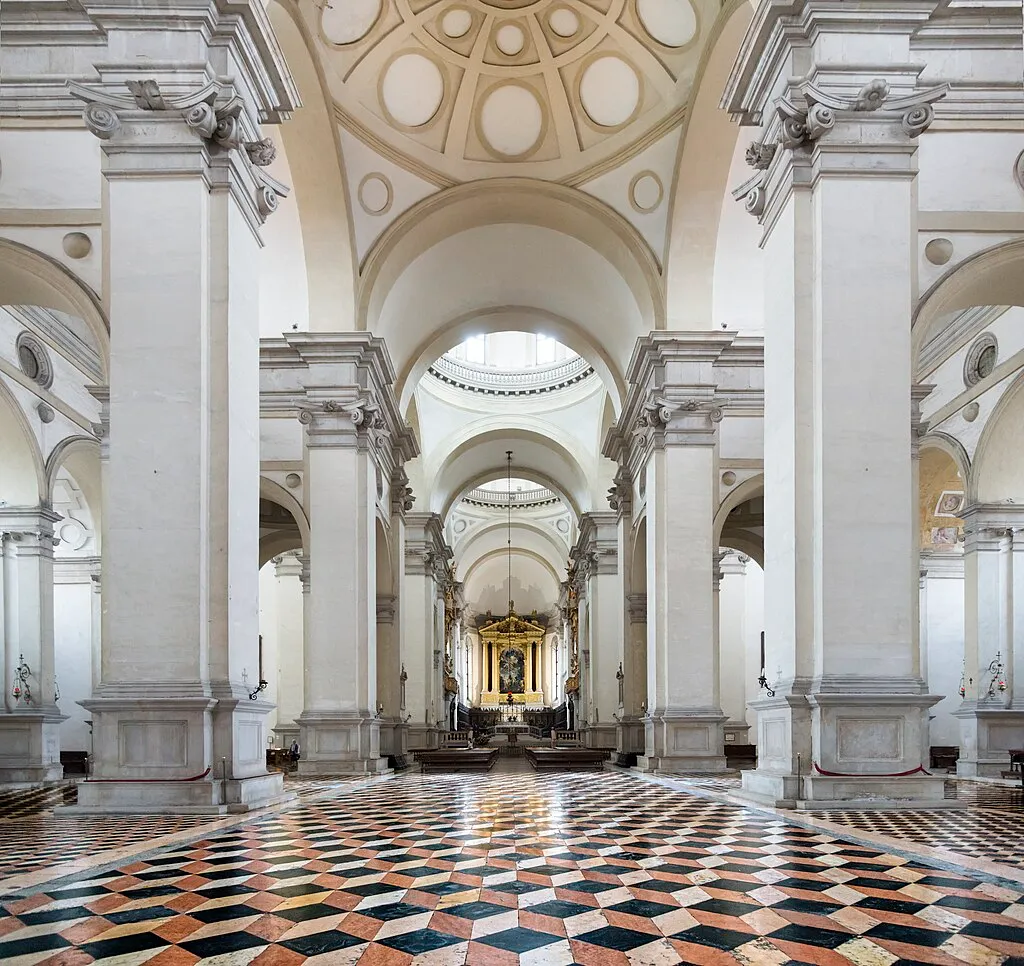
Interior of the Basilica
The Basilica of Santa Giustina has a Latin cross layout, with its main axis extending from east to west. Measuring 118.5 meters (389 feet) in length and 82 meters (269 feet) in width, it is the seventh-largest basilica in Italy. The church’s façade is enhanced by its expansive view of the Prato della Valle, a large square in Padua, providing a dramatic backdrop. Inside, the basilica is divided into several key sections, including the presbytery with the choir, two chapels dedicated to Saints Luke and Matthew that form the transepts, and a series of smaller chapels. The basilica features six smaller chapels along each aisle, each with a square floor plan. The 26 pillars supporting the roof domes are arranged so that each dome sits directly on the barrel vaults. The central bays of the basilica are covered by eight lead-covered domes, with the central dome standing nearly 70 meters (230 feet) tall and topped by a copper statue of Saint Giustina, approximately 5 meters (16 feet) high. The floor, laid between 1608 and 1615, features a geometric design made from yellow, white, and red marble, including several pieces of Greek marble from the ancient Basilica Opilionea.
Chapels of the Left Nave
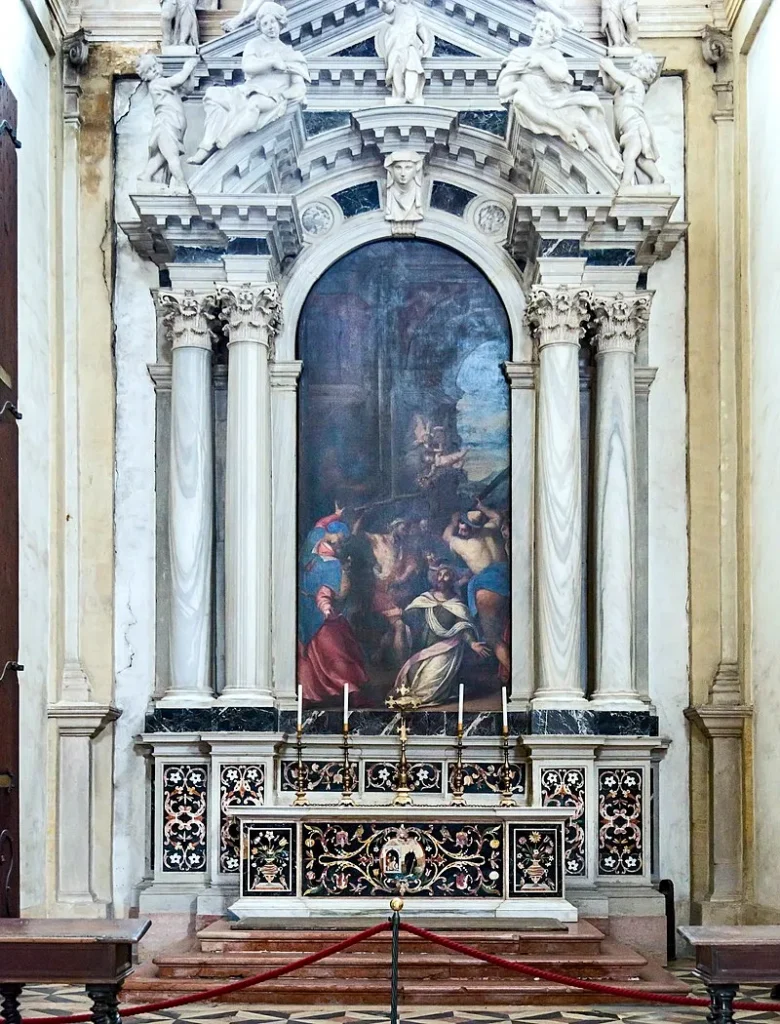
The left nave of the Basilica of Santa Giustina is home to seven chapels, each with a unique dedication and exquisite artwork. The first chapel, Capella di San Giacomo, honors Saint James the Less, with an altar in polychrome stones, designed by the Corbarelli family, and an oil painting by Carlo Caliari depicting his martyrdom. Capella di San Gregorio Magno, dedicated to Pope Gregory I, features a 19th-century altar made of African green marble and Carrara white marble, with an altarpiece by Sebastiano Ricci illustrating Gregory I invoking the Virgin to end the plague. In the Capella di San Daniele Levita, dedicated to Daniel of Padua, the altar is crafted from red marble from France and Carrara and Padua marbles, with a 1677 painting by Antonio Zanchi showing Saint Daniel’s martyrdom. The fourth chapel, Capella di San Placido, honors Saint Placid the Martyr, with an altarpiece by Luca Giordano depicting the martyrdom of Saint Placidus and companions. The Capella di San Mauro is dedicated to Saint Maurus, featuring a black and white marble altarpiece with an oil painting by Valentin Le Febvre, portraying Saint Maurus invoked by the sick. Capella di Giuliano Martire houses the tomb of Saint Julien and a statue sculpted by Giovanni Comin. The final chapel on the left side, Capella di Santa Felicita, displays a monumental altar housing the urn with the saint’s remains, discovered in 1502. The altar and sculptures, including the statue of Saint Felicity in prayer by Orazio Marinali, are adorned with white and red marble, with the refined decorations by the Corbarelli brothers, showcasing fountains, gardens, and an unfinished façade of the basilica.
Left Transept
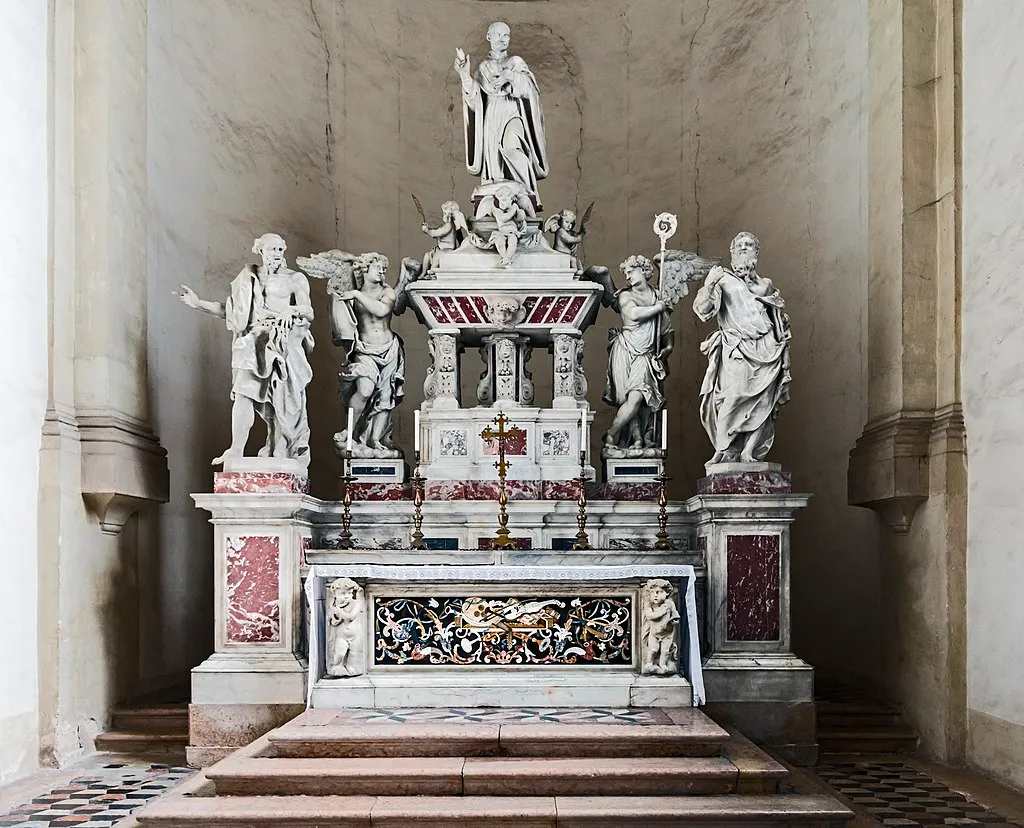
Chapel of Saint Luke
The large chapel in the left transept was reorganized following the Second Vatican Council to accommodate liturgical changes. At the center of the chapel is a monument from 1313, which houses the relics of Saint Luke the Evangelist. Commissioned by Abbot Gualpertino Mussato, the monument was originally placed in the Gothic chapel in 1562. Made from serpentine and Verona marble, the monument is decorated with eight alabaster bas-relief panels depicting angels and symbols related to the saint. It is supported by two granite columns and two spiral alabaster columns, with a central support made of Greek marble featuring caryatid angels. At the top of the monument is a 16th-century altarpiece, attributed to Alessandro Bonvicino, depicting the Virgin Salus Populi Patavini of Constantinople. This Byzantine icon, traditionally believed to have been painted by Saint Luke, was brought to Padua to protect it from the iconoclastic turmoil in Constantinople.
Chapel of Blessed Arnaldo da Limena
This chapel is dedicated to Blessed Arnaldo da Limena, also known as Arnaud Cataneo. The altar was created in 1681, with the angels and statue above the urn containing Blessed Arnaldo’s relics sculpted by Bernardo Falcone. Statues of Saint Peter and Saint Paul, crafted by Orazio Marinali and Michele Fabris, are also featured in the chapel. The altar’s polychrome stone marquetry was made by the Corbarelli family. On the large wall to the right of the chapel is a significant painting by Antonio Balestra (1718), depicting the Martyrdom of Saints Cosmas and Damian. On the opposite wall is another important piece, The Great Massacre of the Innocents, painted by Sebastiano Galvano in the mid-16th century. This painting originally hung in the Church of San Benedetto Novello.
The Choir and Key Chapels of the Basilica of Santa Giustina
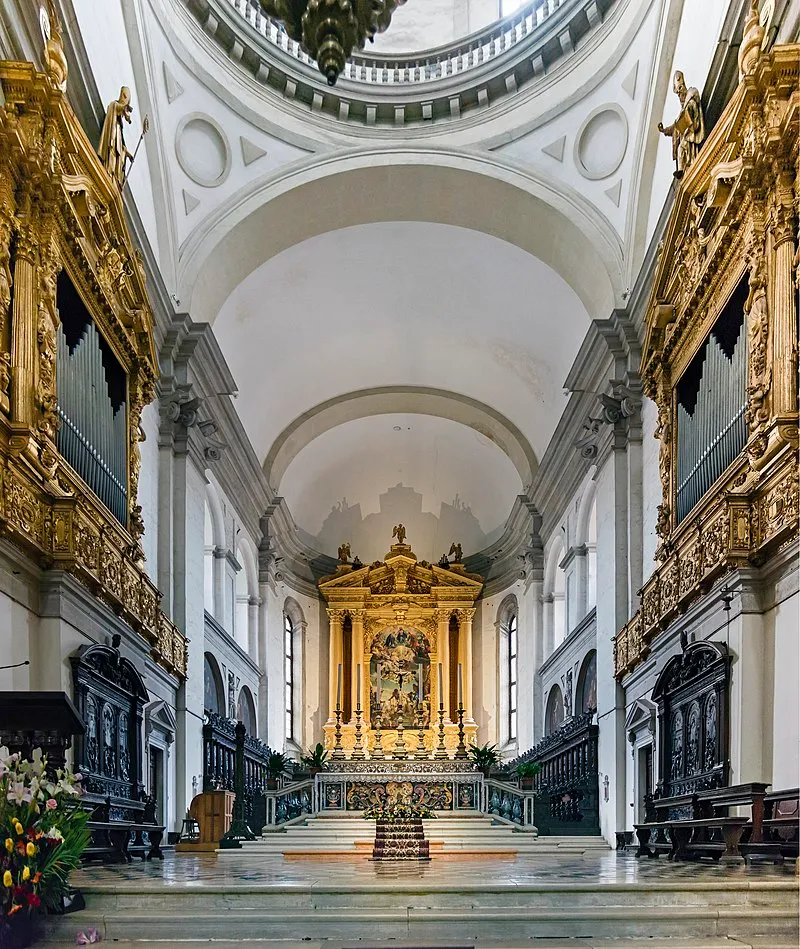
The Choir
The elevated choir, accessible via a monumental staircase, overlooks the nave and houses the crypt below, which now serves as a winter chapel. The balustrades of the choir are crafted by Francesco Contini (1630). At the top, two busts of Roman patricians, Vitaliano and Opilione, flank the niches on either side, created by Giovanni Francesco de Surdis in 1561. The high altar of the basilica is a masterwork in “Florentine” style, combining intricate inlays of marble with precious materials such as mother-of-pearl, coral, lapis lazuli, carnelian, and pearls. This delicate work was completed between 1637 and 1643 under the direction of Pietro Paolo Corbarelli, following a design by Giovan Battista Nigetti. On October 7, 1627, the body of Saint Justine was placed beneath this altar. The altarpiece, “The Martyrdom of Saint Justine,” painted by Paolo Veronese in 1576, adorns the altar, depicting her suffering in vivid detail.
Chapel of the Blessed Sacrament
Initially home to the relics of the Innocent Saints, this chapel is now dedicated to the Blessed Sacrament. The ceiling, painted around 1700 by Sebastiano Ricci, is adorned with frescoes depicting angels and apostles adoring the Blessed Sacrament. Ricci employs trompe l’oeil techniques to create the illusion of depth and grandeur, particularly with the depiction of the Eternal Father and the Apostles, who seem to hover above the chapel walls, all gazing toward the Eucharist. The altar, a monumental piece completed in stages during the 1640s, was designed by Lorenzo Bedogni and Pietro Paolo Corbarelli, with the final touches made by Giuseppe Sardi and Josse the Court. Two angels worshiping the Blessed Sacrament are sculpted by the latter, while the bronze statues adorning the Tabernacle were cast by Carlo Trabucco in 1697. The intricate sculptures by Michele and Alessandro Fabris Tremignon further enhance the altar’s beauty.
Chapel of the Piety
Designed by Genoese artist Filippo Parodi in 1689, this chapel is renowned for its architectural, decorative, and sculptural grandeur. The chapel’s ceiling features a stucco angelic crowd, adding a sense of divine presence to the space. At the center of the chapel stands the Pietà, flanked by statues of Mary Magdalene and Saint John the Apostle, all sculpted by Parodi. The chapel itself, with its deeply moving composition, has been a place of reflection and reverence for centuries.
Right Transept
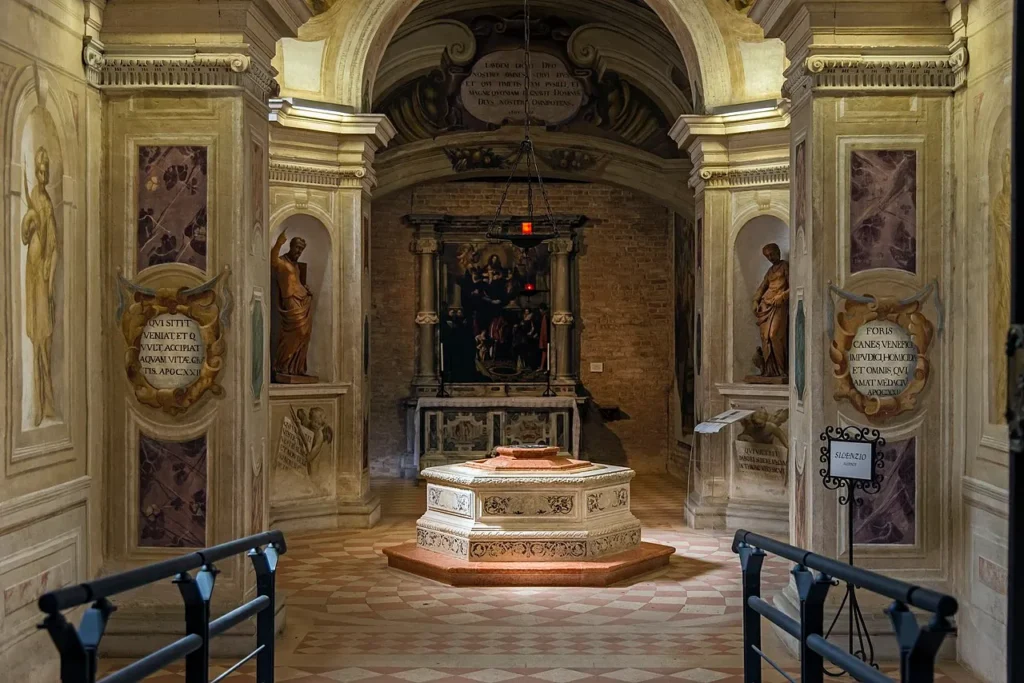
Chapel of Saint Maximus of Padua
Dedicated to Saint Maximus, the second bishop of Padua, this chapel houses a tomb containing his relics. The altar is adorned with a statue group of Saint Maximus, the angels bearing the insignia of the bishop, and Saint James, sculpted by Michele Fabris in 1681. The statue of Saint Bartholomew was created by Bernardo Falcone in 1682. The marquetry altar of polychrome stone was crafted by the Corbarelli family, adding a unique touch of craftsmanship to this sacred space.
Chapel of Saint Matthias
A space of great significance, the Chapel of Saint Matthias features two imposing canvases: The Mission of the Apostles (1631) by Battista Bissoni and Saints Cosmas and Damian Saved by the Angel (1718) by Antonio Balestra. Beneath these works, confessionals and a seventeenth-century pulpit stand. At the chapel’s base rests the tomb of Saint Matthias the Apostle, housed in a monument made of Greek and African marble. This reliquary tomb, completed in 1562 by Giovanni Francesco de Surdis, is modeled after the reliquary tomb of Saint Luke. The vault, decorated in the Renaissance style, complements the magnificent bas-reliefs, attributed to the circle of Bartolomeo Bellano, surrounding the tomb. A small alabaster temple with intricate ironwork holds a representation of the Virgin.
The Corridor of the Martyrs
Accessible from the right transept, the Corridor of the Martyrs was constructed in 1564 on the site of the ancient abbey church of the Middle Ages. It was designed to provide access to the Sanctuary of Saint Prosdocimus of Padua. The corridor is adorned with 16th- and 17th-century frescoes and features a counter-vaulted ceiling. In the middle of the corridor is an octagonal space with a dome decorated with frescoes by Giacomo Ceruti. At its center is the Well of the Martyrs, built by Abbot Angelo Sangrino in 1565 above the medieval well. The marble and alabaster well is finely crafted, with a grid that allows visitors to view the bones of the martyrs discovered in 1269 by Blessed Giacoma. The corridor also showcases the mosaic decoration from the Opilionea basilica of the sixth century, along with a 16th-century altar, an artwork by Pietro Damini, and statues of Saints Peter and Paul sculpted by Francesco Segala.
The Sanctuary of Prosdocimus
At the end of the Corridor of the Martyrs is the Sanctuary of Saint Prosdocimus of Padua, one of the oldest buildings in Veneto, dating back to the 6th century. It is the only surviving part of the Opilionea basilica. Originally a chapel dedicated to preserving relics, the sanctuary is designed in the shape of a Greek cross. Its elegant sixteenth-century dome, painted in grotesque style, replaced the original mosaic decoration. The sanctuary was the burial place for the first bishops of Padua, including Saint Prosdocimus, whose body rests beneath the altar. The altar, completed in 1564, houses a Roman sarcophagus with a 5th-century bas-relief depicting Saint Prosdocimus. Along the walls of the entrance hall are remnants of 12th-century frescoes, while the tympanum of the door is a remnant of the sixth-century basilica.
Right Side of the Nave: Chapels and Altars
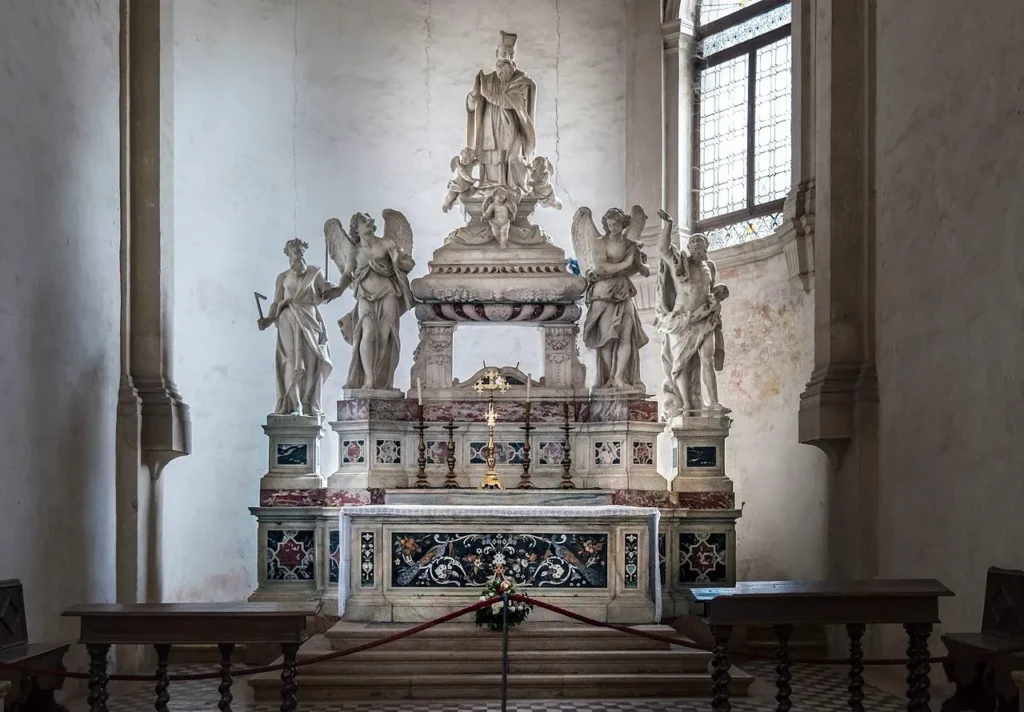
The right side of the nave is home to several chapels, each with its own unique artistic and historical significance. The Chapel of Sant’Urio is dedicated to the priest who safeguarded the relics of St. Luke, St. Matthew, and an Icon of the Virgin during the iconoclastic fury in Constantinople. The altar, with its arch dating from 1682, houses the remains of Sant’Urio, and the altarpiece features a statue of the saint, along with angels and statues of Saints Thomas and Thaddeus, all crafted by Bernardo Falcone. The beautiful marquetry in polychromatic stones is the work of the Corbarelli family. The Chapel of the Holy Innocents, built in the first half of the 17th century, originally housed the Blessed Sacrament but was later repurposed in 1675 to hold the relics of the victims of Herod, the Holy Innocents. The chapel’s decoration includes The Disarray of Santa Rachel by Giovanni Comin and statues of Saints James the Minor and John by Michele Fabris. The Chapel of Saint Benedict features an altar made of black and white Genoese marble, with an altarpiece painted by Palma the Younger that shows Saint Benedict welcoming Saints Placid and Maurus. The Chapel of Saint Scholastica is marked by columns of Salò marble supporting its altar, while the altarpiece, painted by Luca Giordano in 1674, depicts the death of Saint Scholastica. The Chapel of Saint Gerard Sagredo contains an altarpiece by Johann Carl Loth from 1674, showing the Martyrdom of Saint Gerard Sagredo. In the Chapel of Saint Gertrude, the altarpiece features Ecstasy of Saint Gertrude, painted by Pietro Liberi. Lastly, the Chapel of the Conversion of Saint Paul boasts an altarpiece attributed to Paolo Veronese, depicting the dramatic moment of Saint Paul’s conversion, along with a supplementary canvas by Gaspare Diziani, formerly housed in the Church of the Terese.
Feast Day
Feast Day: 7th October
Justina of Padua (Italian: Santa Giustina di Padova; Venetian: Santa Justina de Pàdoa) is a Christian saint and a patroness of the city of Padua. Her feast day is October 7.
Church Mass Timing
Saturday : 6:00 PM
Sunday : 8:15 AM , 9:30 AM , 11:00 AM and 6:30 PM
Church Opening Time:
Monday : 7:30 am – 12:00 pm, 3:00 pm – 6:00 pm
Tuesday : 7:30 am – 12:00 pm, 3:00 pm – 6:00 pm
Wednesday : 7:30 am – 12:00 pm, 3:00 pm – 6:00 pm
Thursday : 7:30 am – 12:00 pm, 3:00 pm – 6:00 pm
Friday : 7:30 am – 12:00 pm, 3:00 pm – 6:00 pm
Saturday : 7:30 am – 12:00 pm, 3:00 pm – 6:00 pm
Sunday : 7:30 am – 12:00 pm, 3:00 pm – 6:00 pm
Contact Info
Address :
Via Giuseppe Ferrari, 2/A, 35123 Padova PD, Italy.
Phone : +390498220411
Accommodations
Connectivities
Airway
Venice Marco Polo Airport to Abbey of Santa Giustina, Padua, Italy distance between 39 min (45.9 km) via Tangenziale di Mestre.
Railway
Padova Railway Station to Abbey of Santa Giustina, Padua, Italy distance between 10 min (4.9 km) via Via Fra’ Paolo Sarpi.

